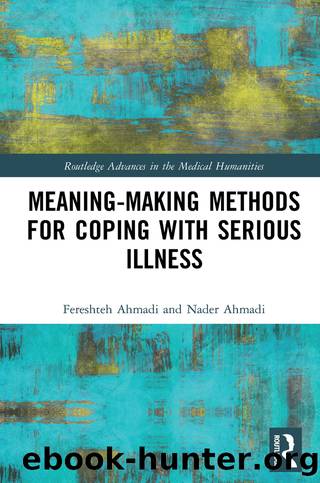Meaning-making Methods for Coping with Serious Illness by Fereshteh Ahmadi Nader Ahmadi

Author:Fereshteh Ahmadi, Nader Ahmadi [Fereshteh Ahmadi, Nader Ahmadi]
Language: eng
Format: epub
Tags: Social Science, Social Work, Sociology, General
ISBN: 9781351578882
Google: L5xeDwAAQBAJ
Publisher: Routledge
Published: 2018-06-04T03:38:34+00:00
Listening to music to ease the pain
Our study revealed that some interviewees reported using traditional Chinese music as a form of meaning-making coping.
A number of publications have described the specific benefits of music for cancer patients. Interactive music interventions â such as instrumental improvisation, drumming and singing â have shown promise in improving the mood of cancer patients (Burns et al., 2005; Cassileth et al., 2003, Krout, 2001; Magill 2009). Some studies have examined the effects of receptive interventions â such as music listening, music and imagery, or of a combination of music therapy interventions â on outcomes such as decreased pain and nausea, improved mood, increased family communication and improved quality of life among cancer patients. Examples of such studies are Burns et al. (2001), Sahler et al. (2003), Cassileth and Gubili (2009), Nainis et al. (2006), Hart (2009), and Kaliyaperumal and Gowri Subash (2010). The integration of music therapy into the healthcare system in various countries is related to, among other things, the dominant culture of the society. China is one of the countries in which music has historically played an important role in patientsâ healing process.
According to Changzhen (2014), physicians in ancient China developed a complex system to incorporate musical notes into the healing process. In Chinaâs first medical text, The Yellow Emperorâs Classic of Medicine, written 2,300 years ago, we find the use of music as therapy. Music therapy is an aspect of five-element theory, which is actually the basis of traditional Chinese medicine. Considering all things in nature to be composed of the elements of earth, water, fire, metal and wood, classical Chinese music was composed on the basis of five notes or sounds: jiao, zhi, gong, shang, and yu. To achieve different healing methods, Chinese medicine has used the relationship between internal organs and their five-element correspondences, such as musical notes. In modern China, Five Phases Music Therapy (FPMT) is still used by physicians. FPMT âemploys the theory of five phases and five music scales or tones (Gong (do), Shang (ri), Jue (mi), Zhi (so) and Yu (la)) to analyze and treat mind-body illnessâ (Zhang 2017).
Studies (Ahmadi 2009, 2010, 2013, 2016; Pavlicevic, 2005; Stige, 2016; Barbara Wheeler, 2002) have shown that the role of music in coping with cancer is not only personal in nature, but also cultural. Thus, the role of culture in applying music as a coping method is important for grasping how and why individual cancer patients use music as a way to cope with their illness.
Briefly, the Chinese may not be inclined toward religion, but may be more interested in philosophy. Moreover, their sense of spirituality seems to be an integrated part of their strong preference for philosophy. It is perhaps for this reason we did not find religious coping methods to be prevalent among our interviewees. Instead, we observed meaning-making coping methods such as sanctification of family and inner peace, which are based on the traditional Chinese philosophical doctrine of the body-mind-spirit relation. The ancient philosophersâ discussions on Yin
Download
This site does not store any files on its server. We only index and link to content provided by other sites. Please contact the content providers to delete copyright contents if any and email us, we'll remove relevant links or contents immediately.
The Rosetta Stone of the Human Mind by Vincenzo R. Sanguineti(183)
Cardiology in a Heartbeat, second edition by Vaswani Amar;Khaw Hwan Juet;El-Medany Ahmed;Dougherty Scott;(181)
TSRA Operative Dictations in Cardiothoracic Surgery by unknow(166)
The Trauma Chronicles by Westaby Stephen(151)
If Joan of Arc Had Cancer : Finding Courage, Faith, and Healing from History's Most Inspirational Woman Warrior by Janet Lynn Roseman(149)
How Selegiline ((-)-Deprenyl) Slows Brain Aging by Joseph Knoll(144)
Clinical Nephrology - 2020 by Weber MD C. G(143)
The Heart Health Bible by John M. Kennedy(142)
Lymphedema (Lymph Obstruction), a Simple Guide to the Condition, Diagnosis, Treatment and Related Conditions by Kenneth Kee(141)
Dear Millie: Diary of a seven year old with cancer by Marco Previero(137)
Fast Facts: Skin Cancer by unknow(130)
Restful Insomnia by Sondra Kornblatt(129)
Rethinking Evidence in the Time of Pandemics: Scientific vs Narrative Rationality and Medical Knowledge Practices by Eivind Engebretsen Mona Baker(129)
Home and Dry by Birgit Bulla(124)
What Your Doctor May Not Tell You About Cholesterol by Stephen R. Devries & Winifred Conkling(123)
Community Engagement, Organization, and Development for Public Health Practice by Murphy Frederick;Frederick Murphy Msphyg Mpia;(123)
Fibromyalgia--Your Treatment Guide by Christine Craggs-Hinton(121)
Medical Materialities by Aaron Parkhurst Timothy Carroll(119)
The Plague of 1665 by Emma Laybourn(117)
